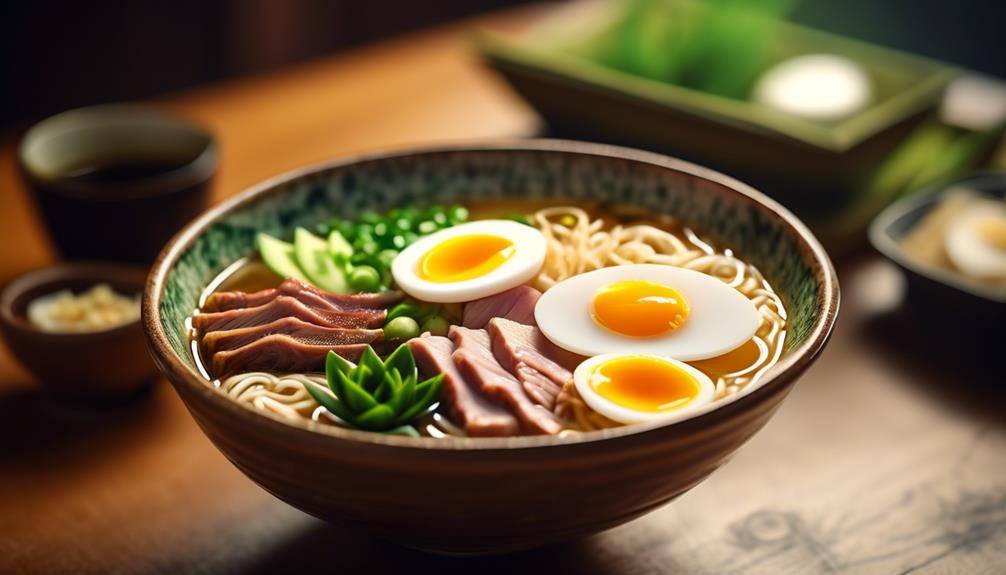Popular Traditional Japanese Ramen Noodle Dishes

Imagine yourself stepping into a steaming bowl of tradition, where every spoonful transports you to the bustling streets of Japan. Traditional Japanese Ramen Noodle Dishes are a symphony of flavors, a harmonious blend of broth, noodles, and toppings that dance upon your taste buds. But there’s more to this culinary masterpiece than meets the eye. From regional variations to vegetarian options, the world of ramen is vast and captivating. So, put on your culinary adventure hat and get ready to savor the secrets of this beloved Japanese comfort food.
Types of Ramen Broths
When it comes to Japanese ramen noodle dishes, the types of broths used are as diverse as they are delicious. Each region in Japan has its own unique take on the classic ramen dish, resulting in a wide range of regional ramen variations. From the rich and creamy tonkotsu broth of Kyushu to the light and delicate shio broth of Hokkaido, there is a ramen broth to suit every taste preference.
One of the most popular regional ramen variations is the miso ramen, which originates from the northern region of Sapporo. This hearty broth is made with fermented soybean paste, giving it a robust and savory flavor. The miso broth is often paired with classic ramen toppings such as marinated bamboo shoots, sliced chashu pork, and a soft-boiled egg.
Another well-known ramen variation is the shoyu ramen, which hails from Tokyo. This broth is soy sauce-based, resulting in a savory and slightly salty flavor profile. The shoyu broth is typically topped with green onions, menma (fermented bamboo shoots), and nori (seaweed).
For those who prefer a lighter and more refreshing option, the shio ramen is the perfect choice. Originating from the coastal region of Hakodate, this broth is seasoned with salt and often garnished with seafood such as clams or shrimp. The shio ramen is typically topped with bean sprouts, corn, and a squeeze of fresh lemon juice.
Regional Variations of Ramen
One cannot discuss Japanese ramen noodle dishes without delving into the fascinating world of regional variations. Each region in Japan has its own unique style of ramen, with distinct flavors and ingredients that reflect the local culinary traditions and preferences. These regional variations have become so popular that they are celebrated at numerous regional ramen festivals held throughout Japan.
The historical origins of ramen can be traced back to China, where it was brought over by Chinese immigrants in the late 19th century. However, it wasn’t until the early 20th century that ramen gained popularity in Japan and started to evolve into the diverse range of regional styles we know today.
One of the most well-known regional variations is Tokyo-style ramen, also known as “shoyu” ramen. It features a clear soy sauce-based broth and thin, curly noodles. This style is characterized by its simplicity and emphasis on the rich umami flavors of the broth.
On the other hand, Hokkaido-style ramen is known for its hearty and thick miso-based broth, which is perfect for the cold winters in the northern region of Japan. The noodles used in Hokkaido-style ramen are typically thicker and chewier, providing a satisfying texture.
Other regional variations include Kyushu-style ramen, which is known for its creamy tonkotsu (pork bone) broth, and Hakata-style ramen, which features thin, straight noodles and a strong pork flavor.
Exploring the regional variations of ramen is a culinary adventure that allows you to experience the diverse flavors and unique characteristics of each region. Whether you prefer the simplicity of Tokyo-style ramen or the heartiness of Hokkaido-style ramen, there is a regional variation that is sure to delight your taste buds. So, next time you have the chance, don’t miss the opportunity to indulge in the world of regional ramen at one of Japan’s renowned ramen festivals.
Popular Ramen Toppings
When it comes to classic ramen toppings, there are a few ingredients that never fail to satisfy. From the rich and savory chashu pork to the perfectly soft-boiled egg, these toppings add depth and flavor to every bowl. But if you’re feeling adventurous, there are also unique ramen additions like corn, butter, and even cheese that can take your ramen experience to a whole new level. Whether you stick to tradition or explore new flavors, the toppings you choose can make all the difference in creating your perfect bowl of ramen.
Classic Ramen Toppings
Classic Ramen Toppings, such as tender slices of chashu pork and marinated soft-boiled eggs, elevate the flavor profile of a humble bowl of ramen to a whole new level of deliciousness. These traditional ramen garnishes not only enhance the taste but also add visual appeal to the dish.
The succulent chashu pork, with its melt-in-your-mouth texture and rich, savory flavor, is a staple topping in ramen. The tender meat complements the noodles and broth perfectly, creating a harmonious balance of flavors. The marinated soft-boiled eggs, with their creamy yolks and tangy marinade, add a burst of richness and depth to each bite. These classic toppings are a testament to the attention to detail and craftsmanship that goes into creating an authentic bowl of Japanese ramen.
Unique Ramen Additions
As you explore the world of Japanese ramen, you’ll discover a plethora of unique and popular toppings that take this beloved dish to new heights of culinary creativity. From traditional condiments like pickled ginger and sesame seeds to more unconventional additions like sweet corn and butter, the possibilities are endless.
These unique ramen condiments add layers of flavor and texture to the already delicious bowl of noodles, elevating it to a whole new level. And if you’re feeling adventurous, you can even try fusion ramen dishes that combine elements from different cuisines, such as kimchi ramen or Thai curry ramen. These innovative creations showcase the versatility of ramen and demonstrate how it can be adapted to suit various tastes and preferences. So go ahead, and embark on a ramen adventure that will tantalize your taste buds and leave you craving for more.
Different Styles of Ramen Noodles
What makes each style of ramen noodle unique and worth trying? Well, it all starts with the different noodle textures and the meticulous ramen noodle making process.
When it comes to ramen, the noodles are one of the most important components. Different styles of ramen noodles offer distinct textures that can greatly enhance the overall experience. For example, there are thin, straight noodles that have a delicate and springy texture. These noodles are often found in Tokyo-style ramen, which is known for its light and clear broth. On the other hand, thick and curly noodles are commonly found in Sapporo-style ramen, providing a chewy and substantial bite that pairs well with the rich miso-based broth.
The making of ramen noodles is an art form in itself. The process involves carefully selecting the right type of flour, kneading the dough to achieve the perfect elasticity, and then rolling it out and cutting it into the desired shapes. Each step is crucial in creating noodles that are not only visually appealing but also have the ideal texture to complement the broth and toppings.
Trying different styles of ramen noodles allows you to explore the diverse flavors and textures that this beloved dish has to offer. Whether you prefer thin and delicate noodles or thick and chewy ones, each style brings its own unique charm and character. So, the next time you have the chance, don’t hesitate to venture outside your comfort zone and savor the wonders of different ramen noodle styles. You won’t be disappointed.
Vegetarian and Vegan Ramen Options
If you’re a vegetarian or vegan looking for ramen options, you’ll be glad to know that there are plenty of delicious choices available. Plant-based broths, such as miso or vegetable broth, offer a flavorful alternative to traditional meat-based broths. Tofu and a variety of vegetables can be added as toppings, providing both protein and a burst of freshness. And if you’re avoiding eggs, there are noodle substitutions made from ingredients like rice or buckwheat that are completely vegan-friendly.
Plant-Based Broth Alternatives
For those seeking a plant-based alternative to traditional meat-based broths, vegetarian and vegan ramen options offer a flavorful and satisfying choice. Plant-based ramen options not only cater to those following a vegetarian or vegan lifestyle but also provide numerous health benefits.
- Health benefits of plant-based broth: Plant-based broths are rich in vitamins, minerals, and antioxidants that contribute to overall well-being. They are lower in saturated fats and cholesterol, making them heart-healthy options. Additionally, plant-based broths are often made from ingredients like mushrooms, seaweed, and miso, which have immune-boosting properties.
- Variety of flavors: Vegetarian and vegan ramen options come in a wide range of flavors, from traditional soy-based broths to innovative combinations of vegetables and spices. These options offer a unique and exciting dining experience, satisfying even the most discerning palates.
- Environmental sustainability: By choosing plant-based broths, you are making a positive impact on the environment. Plant-based ingredients require fewer resources and produce fewer greenhouse gas emissions compared to animal-based broths. This choice aligns with a more sustainable and eco-friendly lifestyle.
Tofu and Vegetable Toppings
Tofu and vegetable toppings add a delightful burst of flavor and texture to vegetarian and vegan ramen dishes, elevating them to a whole new level of deliciousness. When it comes to tofu and vegetable stir fry, the combination of the lightly crispy tofu and the vibrant assortment of vegetables creates a harmonious balance of flavors. The tender tofu absorbs the savory sauce, while the vegetables provide a refreshing crunch.
This topping is perfect for those who crave a hearty and satisfying meal without the need for meat. On the other hand, tofu and vegetable curry brings a rich and aromatic twist to ramen. The creamy curry sauce coats the tofu and vegetables, infusing them with warmth and depth of flavor. The combination of spices and vegetables creates a comforting and satisfying meal that is sure to please any vegan or vegetarian ramen lover.
Noodle Substitutions for Vegans
To enhance the vegan ramen experience, there are a variety of noodle substitutions available that offer a delectable alternative to traditional egg-based noodles. These noodle alternatives not only cater to the dietary preferences of vegans but also bring a unique flavor and texture to the dish. Here are three sub-lists of noodle substitutions that can elevate your vegan ramen recipes:
- Rice Noodles: Made from rice flour, these thin and translucent noodles provide a light and delicate texture to your ramen. They are gluten-free and absorb the flavors of the broth beautifully.
- Soba Noodles: These Japanese buckwheat noodles offer a nutty and earthy flavor to your ramen. They are high in fiber and provide a chewy texture, making them a great option for vegan ramen dishes.
- Udon Noodles: Thick and chewy, udon noodles are made from wheat flour and are a popular choice for vegan ramen. They have a mild flavor and can hold up well in hearty broths.
Try these noodle alternatives in your vegan ramen recipes to create delicious and satisfying bowls of comfort.
Ramen Etiquette and Traditions
When enjoying a bowl of ramen, it is essential to respect the etiquette and traditions that surround this beloved Japanese dish. Ramen eating customs have evolved over time, reflecting the historical significance of ramen in Japanese culture.
First and foremost, it is important to slurp your noodles while eating ramen. In Japan, slurping is not considered impolite; rather, it is a sign that you are enjoying the dish and appreciating the flavors. Slurping also helps to cool down the noodles, allowing you to savor each bite without burning your tongue.
Another custom to keep in mind is the proper way to hold your chopsticks. Unlike other Asian countries, Japanese chopsticks should not be crossed or stuck vertically into the bowl. Instead, rest them on a chopstick holder or the edge of your bowl when not in use.
When it comes to adding condiments to your ramen, follow the lead of the locals. Some ramen shops provide a variety of condiments, such as pickled ginger, garlic, and chili oil. Experiment with these flavors, but be mindful not to overpower the delicate balance of the broth and noodles.
Traditionally, ramen is enjoyed at a fast pace. It is considered rude to linger over your bowl for too long, as ramen is meant to be eaten while the noodles are still hot and the broth is flavorful. Take the time to savor each bite, but try not to linger excessively.
Homemade Ramen Recipes
As you explore the world of homemade ramen recipes, you’ll discover a delightful array of flavors and ingredients that allow you to create your own unique bowl of this beloved Japanese dish. Homemade ramen offers endless possibilities, from traditional variations to innovative twists that cater to your personal taste. Here are some homemade ramen variations and cooking techniques that will take your culinary journey to the next level:
- Vegetarian Ramen: For those seeking a meat-free option, vegetarian ramen is a wonderful choice. Replace the traditional pork broth with a rich vegetable broth simmered with kombu seaweed and dried shiitake mushrooms for a deep umami flavor. Top it off with an assortment of fresh vegetables like bok choy, bean sprouts, and corn for a satisfying and wholesome bowl.
- Spicy Miso Ramen: If you crave a kick of heat, try adding some spicy miso paste to your ramen. The combination of the miso’s savory depth and the fiery chili will create a bold and robust flavor profile. Enhance it further by adding marinated tofu, sliced green onions, and a soft-boiled egg for a complete and satisfying meal.
- Seafood Ramen: Seafood lovers can indulge in the ocean’s bounty with a seafood ramen. Use a seafood-based broth infused with bonito flakes and dried sardines for a delicate and briny essence. Add a medley of fresh seafood like shrimp, clams, and scallops, along with some nori strips and a squeeze of citrus for a refreshing and light ramen experience.
Experiment with different cooking techniques, such as making your own noodles from scratch or perfecting the art of slow-cooking the broth for hours to extract maximum flavor. The possibilities are endless when it comes to homemade ramen, so let your creativity soar and enjoy the process of crafting your own mouthwatering bowl of this iconic Japanese comfort food.
Traditional Japanese Ramen Noodle Dishes; Frequently Asked Questions
Are Ramen Noodles Gluten-Free?
Yes, ramen noodles can be gluten-free. There are gluten-free ramen brands available, as well as alternative gluten-free noodle options like rice noodles or soba made from buckwheat.
Can I Substitute the Pork Broth With a Vegetarian Option?
Yes, you can substitute the pork broth with a vegetarian option when making traditional Japanese ramen noodle dishes. There are plenty of vegan ramen options available that can provide the same rich and flavorful broth.
Are There Any Specific Rules for Eating Ramen in Japan?
When enjoying a bowl of ramen in Japan, remember these etiquette rules: slurp your noodles, don’t ask for modifications, and finish everything. As for toppings, try adding chashu pork, soft-boiled egg, and green onions for the best experience.
What Are Some Common Mistakes to Avoid When Making Homemade Ramen?
When making homemade ramen, avoid using overcooked noodles and neglecting to properly season the broth. These common mistakes can result in a lackluster dish that fails to capture the true essence of delicious ramen.
Is There a Specific Way to Slurp Noodles in Japanese Culture?
When it comes to slurping noodles in Japanese culture, there is a specific way to do it. Slurping etiquette is highly valued and has cultural significance, symbolizing the enjoyment of the dish and showing appreciation to the chef.
Conclusion
In conclusion, traditional Japanese ramen noodle dishes offer a wide range of flavors and textures that are sure to satisfy any palate. The various types of broths, regional variations, and unique toppings make each bowl of ramen a culinary adventure. Whether you prefer a rich and savory tonkotsu broth or a lighter miso-based soup, there is a ramen dish for everyone. With its rich history and cultural significance, ramen is more than just a meal – it’s a delightful experience that should not be missed.








